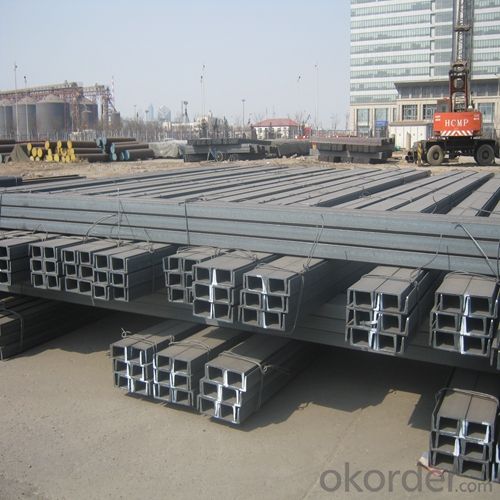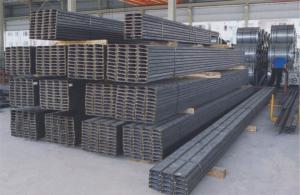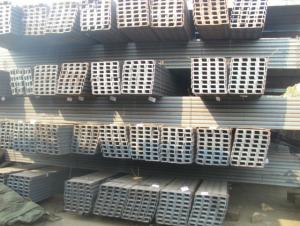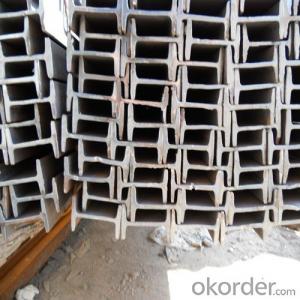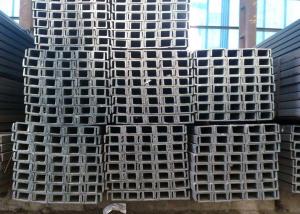H-Beam Structure Steel U-Channel JIS Standard GB Standard
- Loading Port:
- Tianjin
- Payment Terms:
- TT OR LC
- Min Order Qty:
- 100 m.t.
- Supply Capability:
- 30000 m.t./month
OKorder Service Pledge
OKorder Financial Service
You Might Also Like
Product Description:
OKorder is offering H-Beam Structure Steel U-Channel JIS Standard GB Standard Good Price at great prices with worldwide shipping. Our supplier is a world-class manufacturer of steel, with our products utilized the world over. OKorder annually supplies products to European, North American and Asian markets. We provide quotations within 24 hours of receiving an inquiry and guarantee competitive prices.
Product Applications:
Hot Rolled H-Beam Structure Steel U-Channel JIS Standard GB Standard are ideal for structural applications and are widely used in the construction of buildings and bridges, and the manufacturing, petrochemical, and transportation industries.
Product Advantages:
OKorder's H-Beam Structure Steel U-Channel JIS Standard GB Standard are durable, strong, and resist corrosion.
Main Product Features:
· Premium quality
· Prompt delivery & seaworthy packing (30 days after receiving deposit)
· Corrosion resistance
· Can be recycled and reused
· Mill test certification
· Professional Service
· Competitive pricing
Product Specifications:
JIS U CHANNEL | Standard h | Sectional b | Dimension s | t | Mass: Kg/m |
(mm) | (mm) | (mm) | (mm) | ||
50x25 | 50 | 25 | 3.0 | 6.00 | 2.37 |
75X40 | 75 | 40 | 3.8 | 7.00 | 5.30 |
75X40 | 75 | 40 | 4.0 | 7.00 | 5.60 |
75X40 | 75 | 40 | 4.5 | 7.00 | 5.85 |
75X40 | 75 | 40 | 5.0 | 7.00 | 6.92 |
100X50 | 100 | 50 | 3.8 | 6.00 | 7.30 |
100X50 | 100 | 50 | 4.2 | 6.00 | 8.03 |
100X50 | 100 | 50 | 4.5 | 7.50 | 8.97 |
100X50 | 100 | 50 | 5.0 | 7.50 | 9.36 |
125X65 | 125 | 65 | 5.2 | 6.80 | 11.66 |
125X65 | 125 | 65 | 5.3 | 6.80 | 12.17 |
125X65 | 125 | 65 | 5.5 | 8.00 | 12.91 |
125X65 | 125 | 65 | 6.0 | 8.00 | 13.40 |
150x75 | 150 | 75 | 5.5 | 7.30 | 14.66 |
150x75 | 150 | 75 | 5.7 | 10.00 | 16.71 |
150x75 | 150 | 75 | 6.0 | 10.00 | 17.90 |
150x75 | 150 | 75 | 6.5 | 10.00 | 18.60 |
Note: We are able to supply other dimensions and sizes, which depends on the customer's requirements for the quantity.
Chemical Composition of Q235B Steel U Channel:
Alloy No | Grade | Element(%) | ||||
C | Mn | S | P | Si | ||
Q235 | B | 0.12-0.20 | 0.3-0.7 | ≦0.045 | ≦0.045 | ≦0.3 |
Physical Properties of Q235B Steel U Channel:
Grade | Yielding Strength Point(Mpa) | ||||
Q235B | Thickness(mm) | ||||
≦16 | >16-40 | >40-60 | >60-100 | ||
≧235 | ≧225 | ≧215 | ≧205 | ||
Tensile Strength(Mpa) | Elongation After Fracture(%) | ||||
Thickness(mm) | |||||
≦16 | >16-40 | >40-60 | >60-100 | ||
375-500 | ≧26 | ≧25 | ≧24 | ≧23 | |
FAQ:
Q1: Why buy Materials & Equipment from OKorder.com?
A1: All products offered byOKorder.com are carefully selected from China's most reliable manufacturing enterprises. Through its ISO certifications, OKorder.com adheres to the highest standards and a commitment to supply chain safety and customer satisfaction.
Q2: How do we guarantee the quality of our products?
A2: We have established an advanced quality management system which conducts strict quality tests at every step, from raw materials to the final product. At the same time, we provide extensive follow-up service assurances as required.
Q3: How soon can we receive the product after purchase?
A3: Within three days of placing an order, we will begin production. The specific shipping date is dependent upon international and government factors, but is typically 7 to 10 workdays.
Images:



- Q: What are the factors that affect the price of steel channels?
- There are several factors that can impact the price of steel channels. 1. Raw material costs: The price of steel channels is heavily influenced by the cost of raw materials, particularly steel. Fluctuations in the price of iron ore, coal, and other materials used in steel production can directly affect the cost of manufacturing steel channels. 2. Supply and demand: The overall demand for steel channels in the market can impact their price. If demand is high and supply is limited, prices are likely to increase. Conversely, if demand is low and there is excess supply, prices may decrease. 3. Manufacturing and processing costs: The cost of producing steel channels, including labor, energy, and equipment expenses, can impact the final price. Higher manufacturing costs may lead to higher prices for steel channels. 4. Market competition: The level of competition among steel channel manufacturers can also influence prices. When there are multiple producers offering similar products, they may engage in price competition to attract customers, resulting in lower prices. Conversely, if there are fewer suppliers or if they have a unique product, prices may be higher. 5. Transportation and logistics: The cost of transporting steel channels from manufacturing facilities to distribution centers or end-users can impact the final price. Factors such as fuel prices, shipping distances, and transportation infrastructure can all affect transportation costs, which may be passed on to the buyer. 6. Government regulations and tariffs: Trade policies, import duties, and government regulations can also affect the price of steel channels. Tariffs imposed on imported steel channels can increase their price, while government subsidies or support can lead to lower prices. 7. Economic conditions: Overall economic conditions, both globally and domestically, can have an impact on steel channel prices. Factors such as economic growth, inflation, and currency exchange rates can all influence the cost of steel channels. It is important to note that these factors are interrelated and can vary depending on the specific market dynamics and location. Therefore, understanding these factors and their potential impact is crucial for buyers and sellers in the steel channel industry.
- Q: How are steel channels protected against rust and corrosion?
- Steel channels are protected against rust and corrosion through various methods such as galvanization, coating with protective paints or sealants, and applying corrosion-resistant treatments to the surface.
- Q: What's the difference between channel type 25a#, 25b# and 25c#?
- Channel steel is a strip of steel with a cross section. The specifications of the method, such as 120*53*5, mean waist height of 120 mm, leg width of 53 mm channel, waist thickness of 5 mm channel, or called 12# channel. The same height of the channel, if there are several different leg width and waist thickness, also need to add a, B, C on the right side of the model, such as 25a#, 25b#, 25c# and so on. Channel steel is divided into ordinary channel steel and light channel steel. Standard Specification for hot-rolled plain channel steel is 5-40#. Specifications for hot rolled flexible channel steel supplied by supply and demand agreement are 6.5-30#. Channel steel is mainly used in building structures, vehicle manufacturing and other industrial structures, and channel steel is often used in conjunction with i-beam.
- Q: What are the different methods for protecting steel channels from water intrusion?
- There are several methods for protecting steel channels from water intrusion. One common method is to apply a waterproof coating or sealant on the surface of the channels. This creates a barrier that prevents water from penetrating into the steel. Another method is to use weatherproof gaskets or seals between the joints of the channels to ensure a tight and secure fit, preventing water from entering. Additionally, proper drainage systems and slope design can help divert water away from the channels, reducing the risk of water intrusion. Regular inspections and maintenance are also crucial to identify and address any potential vulnerabilities or damages that could lead to water penetration.
- Q: What are the different methods of strengthening steel channels against bending?
- To enhance the resistance of steel channels against bending, there are multiple approaches that can be employed: 1. Augmenting the cross-sectional area of the channel: One effective way to strengthen a steel channel is by increasing its cross-sectional area. This can be accomplished by utilizing a thicker channel or incorporating supplementary steel plates or sections to expand the overall area. 2. Employing reinforcement plates or stiffeners: By attaching reinforcement plates or stiffeners to the weak points of the channel, its ability to withstand bending can be significantly improved. These plates or stiffeners are typically welded to the channel and aid in distributing the applied loads more uniformly, thus reducing the risk of bending. 3. Introducing flanges or lips: Another viable method involves adding flanges or lips to the edges of the channel. These supplementary steel sections enhance the rigidity of the channel, rendering it more resistant to bending. 4. Implementing bracing or truss systems: Bracing or truss systems can be utilized to provide support to the steel channel and prevent bending. These systems consist of additional steel members, such as braces or trusses, that are connected to the channel to offer extra support and distribute the applied loads. 5. Utilizing heat treatment: Heat treatment techniques like quenching and tempering can be employed to fortify the steel channel. These processes involve heating the channel to a specific temperature and then rapidly cooling it to increase its hardness and strength. 6. Employing cold working techniques: Cold working techniques like cold rolling or cold drawing can also be used to strengthen steel channels against bending. These processes involve shaping the channel at low temperatures, thereby enhancing its strength and toughness. It is important to note that the choice of method depends on various factors, including the specific application, the desired level of strength, and the available resources and equipment. It is advisable to consult with a structural engineer or steel fabrication expert to determine the most suitable method for strengthening steel channels against bending in a particular situation.
- Q: Can steel channels be used in the construction of mezzanine floors?
- Mezzanine floors, which are commonly utilized in industrial and commercial settings to expand available space, can indeed incorporate steel channels. Renowned for their durability and strength, steel channels are frequently employed in construction projects. Within mezzanine floor construction, steel channels serve as beams or joists, offering essential structural support. Their ability to endure substantial loads ensures a dependable and secure platform for various applications, including storage, offices, and additional workspace. Moreover, steel channels can be tailored to meet specific design and structural prerequisites, rendering them an adaptable option for mezzanine floor construction.
- Q: Do you have any width 20 cm wide? What's the model number and how much is it?
- Channel steel at present market price of about 4580 yuan per ton, you can calculate the price of channel per meter.If the width of the leg was 200, there would be no such model. The largest standard type of channel steel is 40C, height 400, leg width 104, waist thickness 14.5.
- Q: What are the different weight classifications for steel channels?
- The weight classifications for steel channels vary depending on the specific dimensions and designations, but common weight classifications include lightweight, medium weight, and heavy weight.
- Q: Can steel channels be used for creating storage racks or shelving units?
- Absolutely, storage racks or shelving units can definitely be created using steel channels. Steel channels are renowned for their robustness and resilience, which makes them perfect for bearing substantial weights. They are effortlessly fabricated and assembled to produce durable and enduring storage solutions. The adaptability of steel channels permits customization and adjustment to fit precise storage demands, such as adjustable shelving heights or various rack arrangements. Furthermore, steel channels can endure demanding surroundings, such as warehouses, garages, or industrial settings, guaranteeing the stability and security of the storage racks or shelving units.
- Q: What are the different types of connections used for steel channels in roof trusses?
- Steel channels in roof trusses can be connected in several different ways. Some commonly used connection types include: 1. Welding: Skilled labor is required to weld the steel channel directly to other components of the roof truss, like gusset plates or other steel members. Although this provides a strong and rigid connection, it can be time-consuming. 2. Bolting: Bolts are used to connect the steel channel to other components of the roof truss. This type of connection is easier to install compared to welding and can be taken apart if necessary. It offers a strong connection, but there is a risk of bolts loosening over time, requiring regular maintenance. 3. Pinning: A pin or bolt is used to connect the steel channel to other components of the roof truss. This allows for rotational movement, which can be advantageous in certain applications. However, additional support may be needed to prevent excessive movement. 4. Cleats: Flat plates known as cleats are bolted or welded to the steel channel and other components of the roof truss. This connection type is commonly used for connecting purlins or rafters to the steel channel. Cleat connections provide good load transfer and are relatively easy to install. 5. Gusset plates: Gusset plates, typically made of steel, are used in conjunction with bolted or welded connections to add strength and rigidity. They are bolted or welded to the steel channel and other components of the roof truss. The choice of connection type depends on various factors, such as structural requirements, load capacity, ease of installation, and maintenance considerations. It is important to consult a structural engineer or a professional with expertise in roof truss design to determine the most suitable connection type for a specific application.
Send your message to us
H-Beam Structure Steel U-Channel JIS Standard GB Standard
- Loading Port:
- Tianjin
- Payment Terms:
- TT OR LC
- Min Order Qty:
- 100 m.t.
- Supply Capability:
- 30000 m.t./month
OKorder Service Pledge
OKorder Financial Service
Similar products
Hot products
Hot Searches
Related keywords







